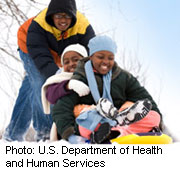
SUNDAY, Jan. 23 (HealthDay News) — Sledding is one of the many outdoor activities that make winter wonderful, but certain safety precautions are needed in order to prevent injuries, say experts.
In 2004 — the most recent year in which sledding injury data was available — sledding, snow tubing and tobogganing accounted for 74,000 injuries treated at U.S. hospital emergency rooms, doctors’ offices and clinics, according to the U.S. Consumer Product Safety Commission.
Here are some sledding safety tips from the American Academy of Pediatrics and emergency room doctors at Cincinnati Children’s Hospital Medical Center:
- Make sure children wear a helmet. Sleds can easily reach speeds of 20-25 mph, according to research. Among sled injuries treated in emergency rooms, about 15 percent are head injuries, and 43 percent of those cases involve brain injuries.
- Maintain constant adult supervision. About 71 percent of unsupervised sledding outings end in injuries, but that rate drops to 29 percent when adults are present, according to an American Association of Orthopaedic Surgeons study.
- Choose a safe site. Check for holes, roots, tree stumps and fences that might be covered in snow. Avoid areas with trees. Don’t use slopes that end in a street, parking lot or pond. There should be a flat run off at the bottom of the hill.
- Have children wear bright colors so that they’re easier to spot and encourage them to dress in layers for extra warmth.
- Allow only one child on the hill at a time. Don’t allow the next sledder to proceed until the previous one is safely off the hill.
- Use a sled with a steering mechanism.
- Don’t use cafeteria trays, cardboard boxes or other sled substitutes.
- Don’t allow children to ride on a sled that’s being pulled by a moving vehicle.
More information
The Nemours Foundation has more about sledding safety.

